Environmental Sustainability
VerifiedAdded on 2023/05/31
|12
|3285
|363
AI Summary
The protection and conservation of the environment has emerged as a main concern for all the States of the world. The aim of every State is to further its economic development so that it can achieve the fulfillment of its national interest and be capable to offer a high standard of living to its citizens.
Contribute Materials
Your contribution can guide someone’s learning journey. Share your
documents today.
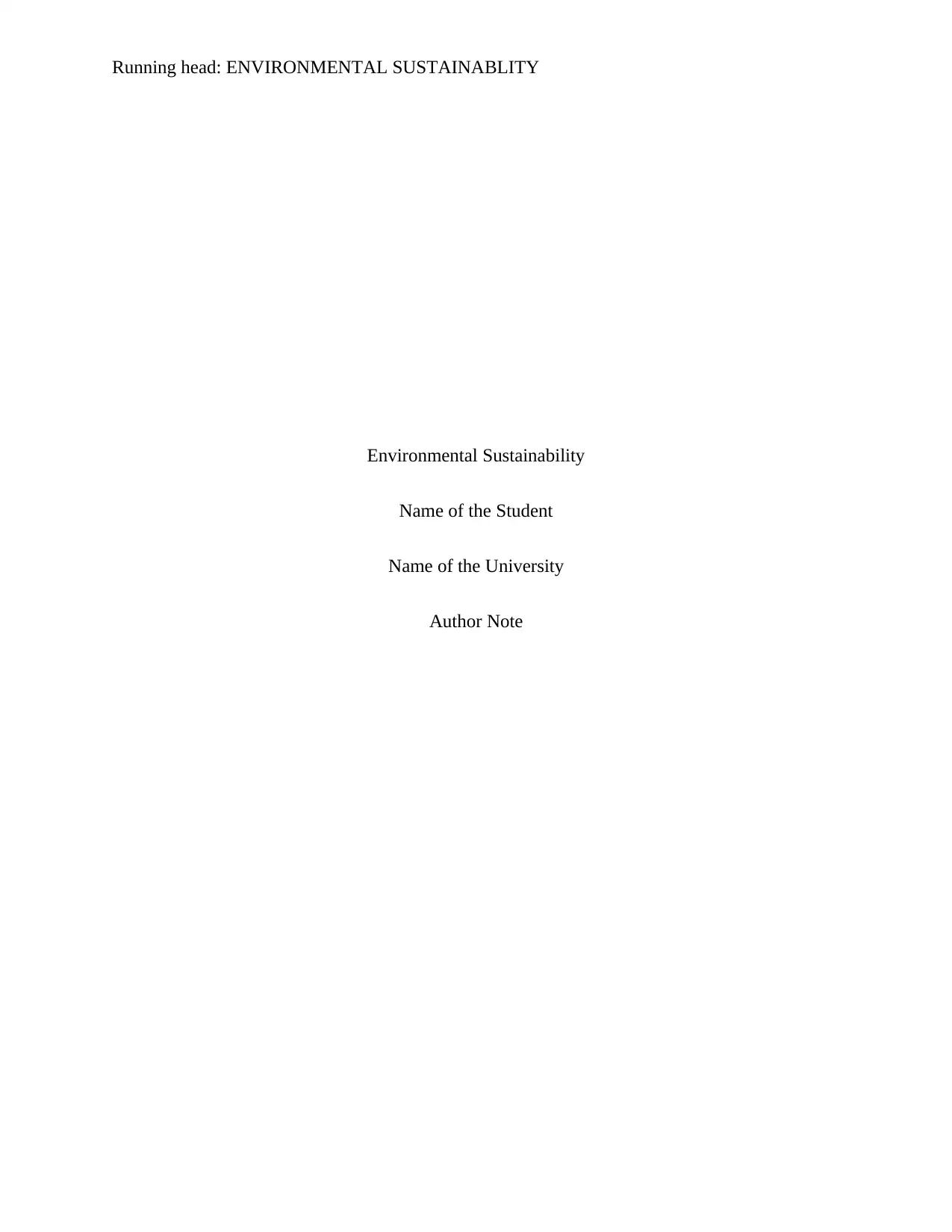
Running head: ENVIRONMENTAL SUSTAINABLITY
Environmental Sustainability
Name of the Student
Name of the University
Author Note
Environmental Sustainability
Name of the Student
Name of the University
Author Note
Secure Best Marks with AI Grader
Need help grading? Try our AI Grader for instant feedback on your assignments.
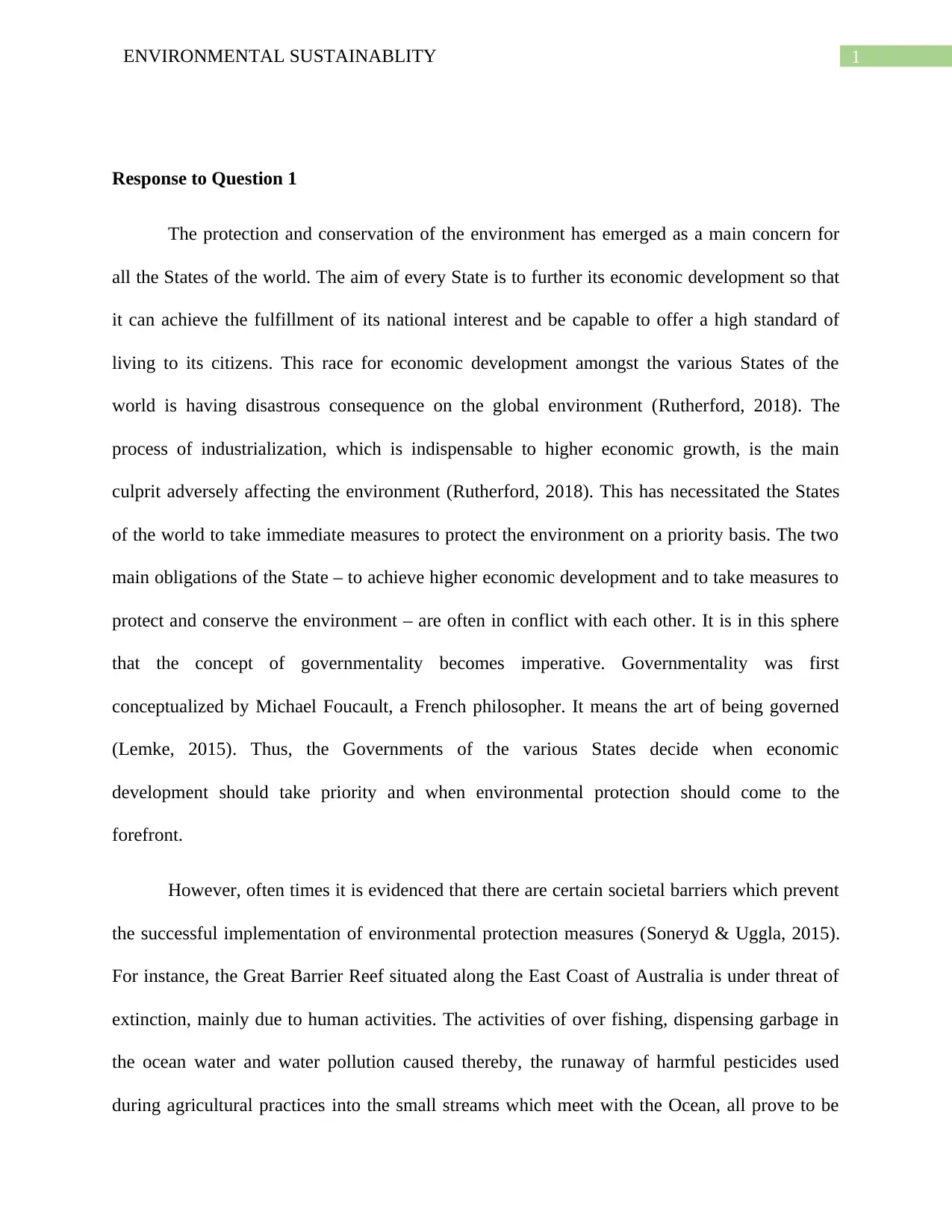
1ENVIRONMENTAL SUSTAINABLITY
Response to Question 1
The protection and conservation of the environment has emerged as a main concern for
all the States of the world. The aim of every State is to further its economic development so that
it can achieve the fulfillment of its national interest and be capable to offer a high standard of
living to its citizens. This race for economic development amongst the various States of the
world is having disastrous consequence on the global environment (Rutherford, 2018). The
process of industrialization, which is indispensable to higher economic growth, is the main
culprit adversely affecting the environment (Rutherford, 2018). This has necessitated the States
of the world to take immediate measures to protect the environment on a priority basis. The two
main obligations of the State – to achieve higher economic development and to take measures to
protect and conserve the environment – are often in conflict with each other. It is in this sphere
that the concept of governmentality becomes imperative. Governmentality was first
conceptualized by Michael Foucault, a French philosopher. It means the art of being governed
(Lemke, 2015). Thus, the Governments of the various States decide when economic
development should take priority and when environmental protection should come to the
forefront.
However, often times it is evidenced that there are certain societal barriers which prevent
the successful implementation of environmental protection measures (Soneryd & Uggla, 2015).
For instance, the Great Barrier Reef situated along the East Coast of Australia is under threat of
extinction, mainly due to human activities. The activities of over fishing, dispensing garbage in
the ocean water and water pollution caused thereby, the runaway of harmful pesticides used
during agricultural practices into the small streams which meet with the Ocean, all prove to be
Response to Question 1
The protection and conservation of the environment has emerged as a main concern for
all the States of the world. The aim of every State is to further its economic development so that
it can achieve the fulfillment of its national interest and be capable to offer a high standard of
living to its citizens. This race for economic development amongst the various States of the
world is having disastrous consequence on the global environment (Rutherford, 2018). The
process of industrialization, which is indispensable to higher economic growth, is the main
culprit adversely affecting the environment (Rutherford, 2018). This has necessitated the States
of the world to take immediate measures to protect the environment on a priority basis. The two
main obligations of the State – to achieve higher economic development and to take measures to
protect and conserve the environment – are often in conflict with each other. It is in this sphere
that the concept of governmentality becomes imperative. Governmentality was first
conceptualized by Michael Foucault, a French philosopher. It means the art of being governed
(Lemke, 2015). Thus, the Governments of the various States decide when economic
development should take priority and when environmental protection should come to the
forefront.
However, often times it is evidenced that there are certain societal barriers which prevent
the successful implementation of environmental protection measures (Soneryd & Uggla, 2015).
For instance, the Great Barrier Reef situated along the East Coast of Australia is under threat of
extinction, mainly due to human activities. The activities of over fishing, dispensing garbage in
the ocean water and water pollution caused thereby, the runaway of harmful pesticides used
during agricultural practices into the small streams which meet with the Ocean, all prove to be
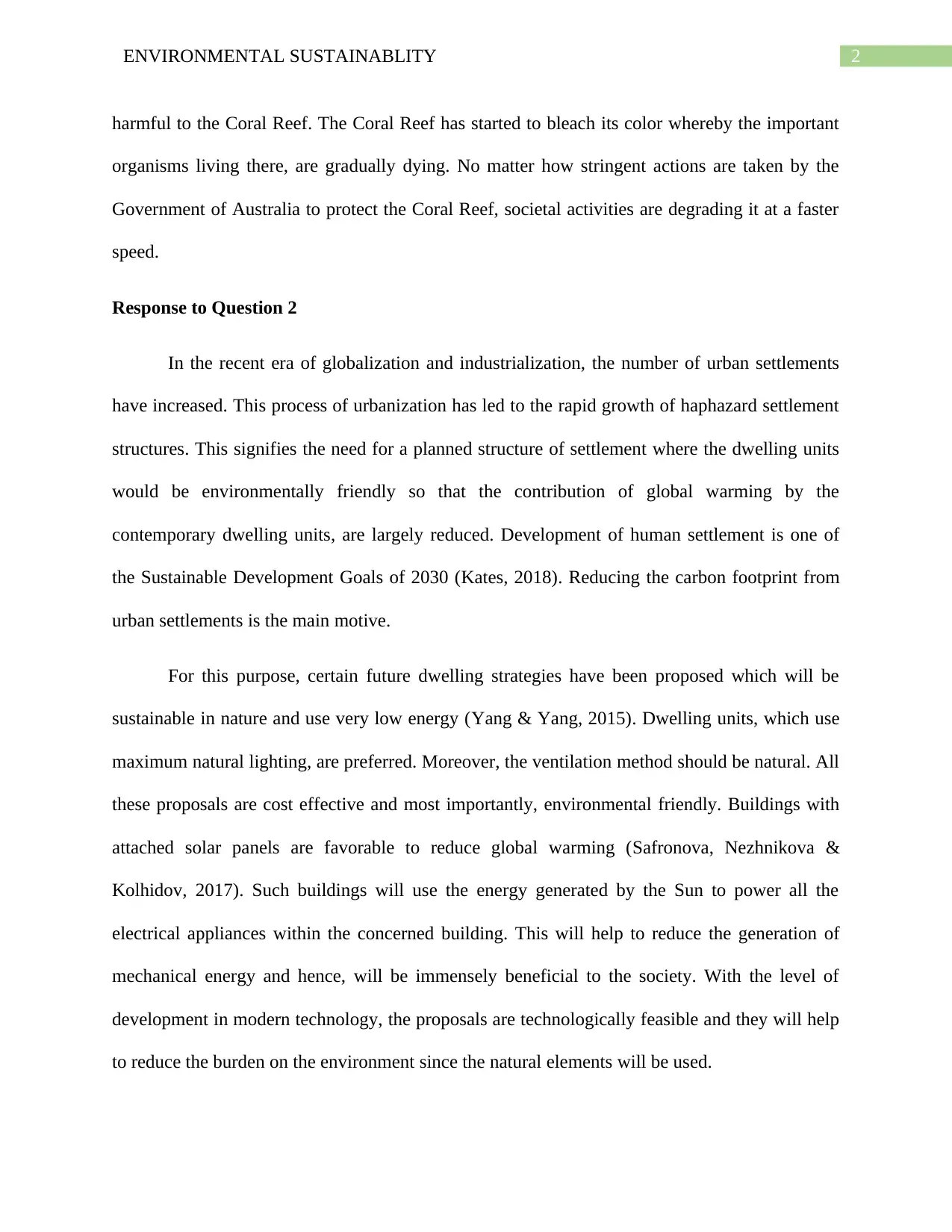
2ENVIRONMENTAL SUSTAINABLITY
harmful to the Coral Reef. The Coral Reef has started to bleach its color whereby the important
organisms living there, are gradually dying. No matter how stringent actions are taken by the
Government of Australia to protect the Coral Reef, societal activities are degrading it at a faster
speed.
Response to Question 2
In the recent era of globalization and industrialization, the number of urban settlements
have increased. This process of urbanization has led to the rapid growth of haphazard settlement
structures. This signifies the need for a planned structure of settlement where the dwelling units
would be environmentally friendly so that the contribution of global warming by the
contemporary dwelling units, are largely reduced. Development of human settlement is one of
the Sustainable Development Goals of 2030 (Kates, 2018). Reducing the carbon footprint from
urban settlements is the main motive.
For this purpose, certain future dwelling strategies have been proposed which will be
sustainable in nature and use very low energy (Yang & Yang, 2015). Dwelling units, which use
maximum natural lighting, are preferred. Moreover, the ventilation method should be natural. All
these proposals are cost effective and most importantly, environmental friendly. Buildings with
attached solar panels are favorable to reduce global warming (Safronova, Nezhnikova &
Kolhidov, 2017). Such buildings will use the energy generated by the Sun to power all the
electrical appliances within the concerned building. This will help to reduce the generation of
mechanical energy and hence, will be immensely beneficial to the society. With the level of
development in modern technology, the proposals are technologically feasible and they will help
to reduce the burden on the environment since the natural elements will be used.
harmful to the Coral Reef. The Coral Reef has started to bleach its color whereby the important
organisms living there, are gradually dying. No matter how stringent actions are taken by the
Government of Australia to protect the Coral Reef, societal activities are degrading it at a faster
speed.
Response to Question 2
In the recent era of globalization and industrialization, the number of urban settlements
have increased. This process of urbanization has led to the rapid growth of haphazard settlement
structures. This signifies the need for a planned structure of settlement where the dwelling units
would be environmentally friendly so that the contribution of global warming by the
contemporary dwelling units, are largely reduced. Development of human settlement is one of
the Sustainable Development Goals of 2030 (Kates, 2018). Reducing the carbon footprint from
urban settlements is the main motive.
For this purpose, certain future dwelling strategies have been proposed which will be
sustainable in nature and use very low energy (Yang & Yang, 2015). Dwelling units, which use
maximum natural lighting, are preferred. Moreover, the ventilation method should be natural. All
these proposals are cost effective and most importantly, environmental friendly. Buildings with
attached solar panels are favorable to reduce global warming (Safronova, Nezhnikova &
Kolhidov, 2017). Such buildings will use the energy generated by the Sun to power all the
electrical appliances within the concerned building. This will help to reduce the generation of
mechanical energy and hence, will be immensely beneficial to the society. With the level of
development in modern technology, the proposals are technologically feasible and they will help
to reduce the burden on the environment since the natural elements will be used.
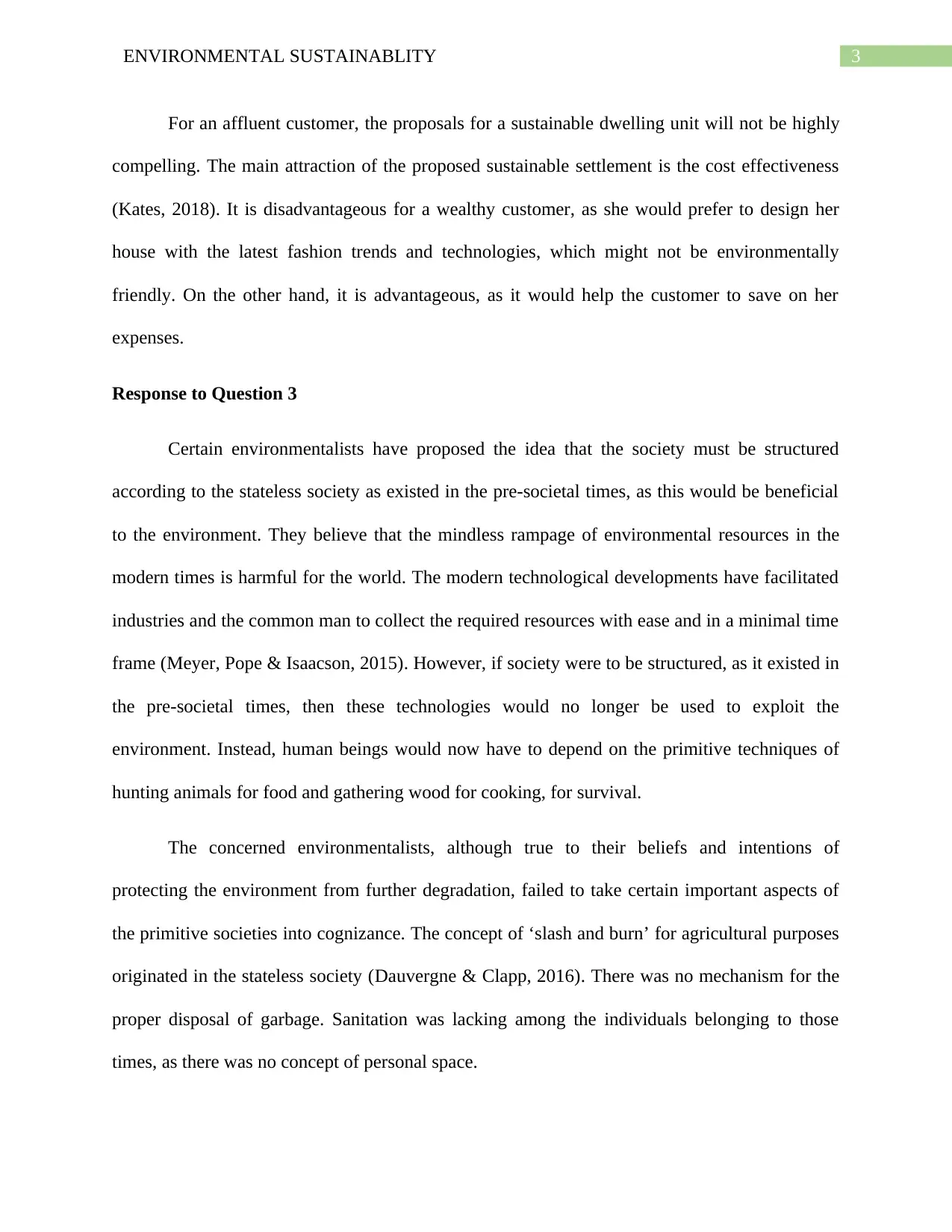
3ENVIRONMENTAL SUSTAINABLITY
For an affluent customer, the proposals for a sustainable dwelling unit will not be highly
compelling. The main attraction of the proposed sustainable settlement is the cost effectiveness
(Kates, 2018). It is disadvantageous for a wealthy customer, as she would prefer to design her
house with the latest fashion trends and technologies, which might not be environmentally
friendly. On the other hand, it is advantageous, as it would help the customer to save on her
expenses.
Response to Question 3
Certain environmentalists have proposed the idea that the society must be structured
according to the stateless society as existed in the pre-societal times, as this would be beneficial
to the environment. They believe that the mindless rampage of environmental resources in the
modern times is harmful for the world. The modern technological developments have facilitated
industries and the common man to collect the required resources with ease and in a minimal time
frame (Meyer, Pope & Isaacson, 2015). However, if society were to be structured, as it existed in
the pre-societal times, then these technologies would no longer be used to exploit the
environment. Instead, human beings would now have to depend on the primitive techniques of
hunting animals for food and gathering wood for cooking, for survival.
The concerned environmentalists, although true to their beliefs and intentions of
protecting the environment from further degradation, failed to take certain important aspects of
the primitive societies into cognizance. The concept of ‘slash and burn’ for agricultural purposes
originated in the stateless society (Dauvergne & Clapp, 2016). There was no mechanism for the
proper disposal of garbage. Sanitation was lacking among the individuals belonging to those
times, as there was no concept of personal space.
For an affluent customer, the proposals for a sustainable dwelling unit will not be highly
compelling. The main attraction of the proposed sustainable settlement is the cost effectiveness
(Kates, 2018). It is disadvantageous for a wealthy customer, as she would prefer to design her
house with the latest fashion trends and technologies, which might not be environmentally
friendly. On the other hand, it is advantageous, as it would help the customer to save on her
expenses.
Response to Question 3
Certain environmentalists have proposed the idea that the society must be structured
according to the stateless society as existed in the pre-societal times, as this would be beneficial
to the environment. They believe that the mindless rampage of environmental resources in the
modern times is harmful for the world. The modern technological developments have facilitated
industries and the common man to collect the required resources with ease and in a minimal time
frame (Meyer, Pope & Isaacson, 2015). However, if society were to be structured, as it existed in
the pre-societal times, then these technologies would no longer be used to exploit the
environment. Instead, human beings would now have to depend on the primitive techniques of
hunting animals for food and gathering wood for cooking, for survival.
The concerned environmentalists, although true to their beliefs and intentions of
protecting the environment from further degradation, failed to take certain important aspects of
the primitive societies into cognizance. The concept of ‘slash and burn’ for agricultural purposes
originated in the stateless society (Dauvergne & Clapp, 2016). There was no mechanism for the
proper disposal of garbage. Sanitation was lacking among the individuals belonging to those
times, as there was no concept of personal space.
Secure Best Marks with AI Grader
Need help grading? Try our AI Grader for instant feedback on your assignments.
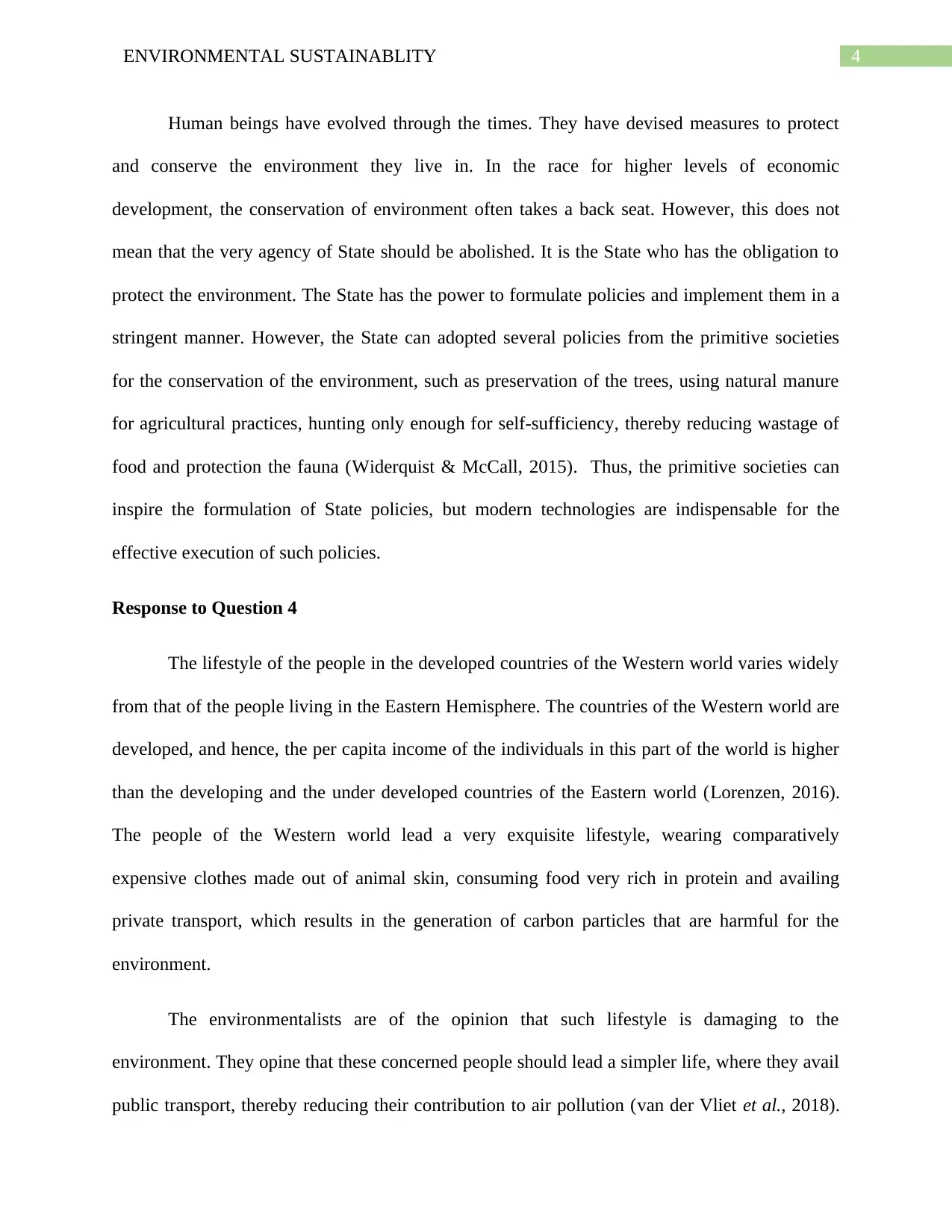
4ENVIRONMENTAL SUSTAINABLITY
Human beings have evolved through the times. They have devised measures to protect
and conserve the environment they live in. In the race for higher levels of economic
development, the conservation of environment often takes a back seat. However, this does not
mean that the very agency of State should be abolished. It is the State who has the obligation to
protect the environment. The State has the power to formulate policies and implement them in a
stringent manner. However, the State can adopted several policies from the primitive societies
for the conservation of the environment, such as preservation of the trees, using natural manure
for agricultural practices, hunting only enough for self-sufficiency, thereby reducing wastage of
food and protection the fauna (Widerquist & McCall, 2015). Thus, the primitive societies can
inspire the formulation of State policies, but modern technologies are indispensable for the
effective execution of such policies.
Response to Question 4
The lifestyle of the people in the developed countries of the Western world varies widely
from that of the people living in the Eastern Hemisphere. The countries of the Western world are
developed, and hence, the per capita income of the individuals in this part of the world is higher
than the developing and the under developed countries of the Eastern world (Lorenzen, 2016).
The people of the Western world lead a very exquisite lifestyle, wearing comparatively
expensive clothes made out of animal skin, consuming food very rich in protein and availing
private transport, which results in the generation of carbon particles that are harmful for the
environment.
The environmentalists are of the opinion that such lifestyle is damaging to the
environment. They opine that these concerned people should lead a simpler life, where they avail
public transport, thereby reducing their contribution to air pollution (van der Vliet et al., 2018).
Human beings have evolved through the times. They have devised measures to protect
and conserve the environment they live in. In the race for higher levels of economic
development, the conservation of environment often takes a back seat. However, this does not
mean that the very agency of State should be abolished. It is the State who has the obligation to
protect the environment. The State has the power to formulate policies and implement them in a
stringent manner. However, the State can adopted several policies from the primitive societies
for the conservation of the environment, such as preservation of the trees, using natural manure
for agricultural practices, hunting only enough for self-sufficiency, thereby reducing wastage of
food and protection the fauna (Widerquist & McCall, 2015). Thus, the primitive societies can
inspire the formulation of State policies, but modern technologies are indispensable for the
effective execution of such policies.
Response to Question 4
The lifestyle of the people in the developed countries of the Western world varies widely
from that of the people living in the Eastern Hemisphere. The countries of the Western world are
developed, and hence, the per capita income of the individuals in this part of the world is higher
than the developing and the under developed countries of the Eastern world (Lorenzen, 2016).
The people of the Western world lead a very exquisite lifestyle, wearing comparatively
expensive clothes made out of animal skin, consuming food very rich in protein and availing
private transport, which results in the generation of carbon particles that are harmful for the
environment.
The environmentalists are of the opinion that such lifestyle is damaging to the
environment. They opine that these concerned people should lead a simpler life, where they avail
public transport, thereby reducing their contribution to air pollution (van der Vliet et al., 2018).
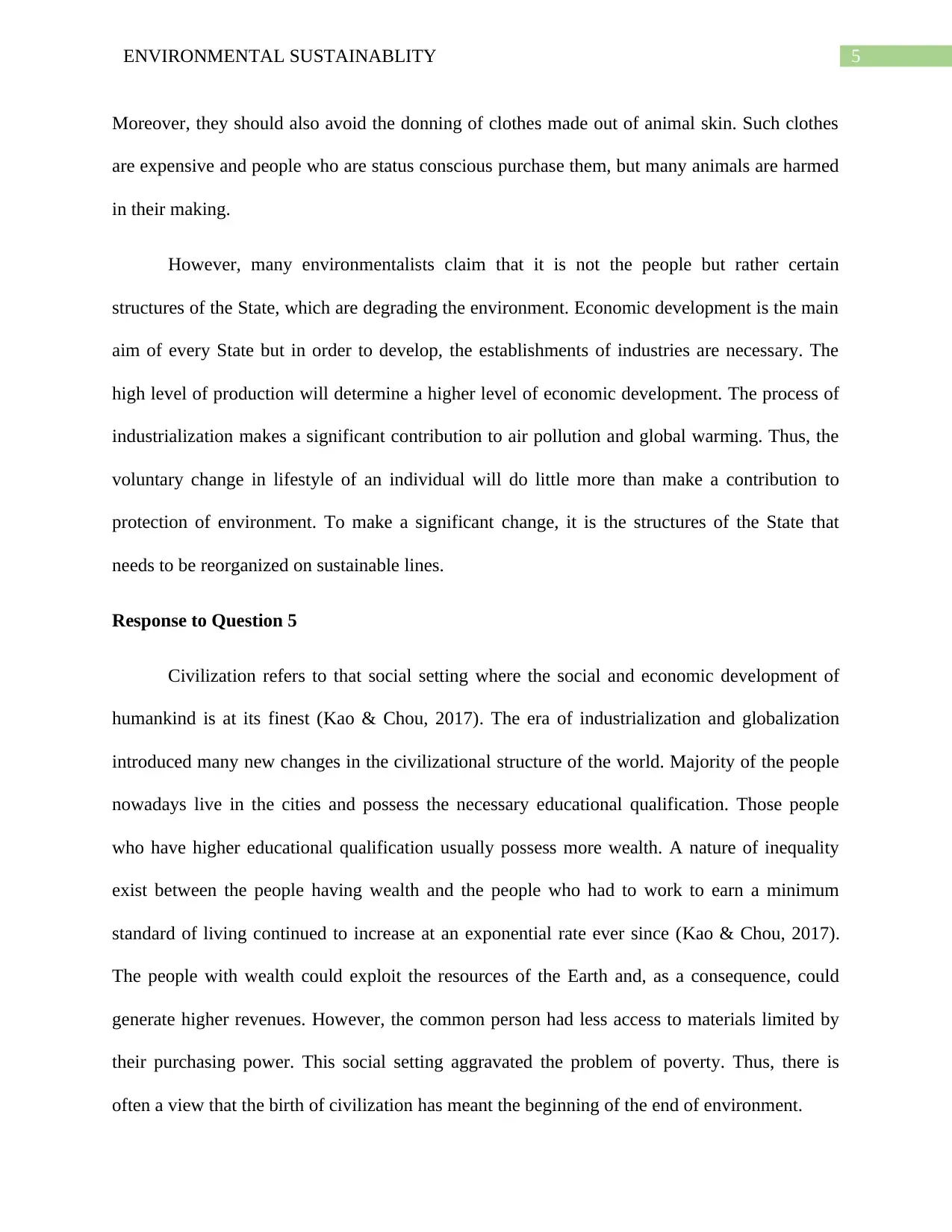
5ENVIRONMENTAL SUSTAINABLITY
Moreover, they should also avoid the donning of clothes made out of animal skin. Such clothes
are expensive and people who are status conscious purchase them, but many animals are harmed
in their making.
However, many environmentalists claim that it is not the people but rather certain
structures of the State, which are degrading the environment. Economic development is the main
aim of every State but in order to develop, the establishments of industries are necessary. The
high level of production will determine a higher level of economic development. The process of
industrialization makes a significant contribution to air pollution and global warming. Thus, the
voluntary change in lifestyle of an individual will do little more than make a contribution to
protection of environment. To make a significant change, it is the structures of the State that
needs to be reorganized on sustainable lines.
Response to Question 5
Civilization refers to that social setting where the social and economic development of
humankind is at its finest (Kao & Chou, 2017). The era of industrialization and globalization
introduced many new changes in the civilizational structure of the world. Majority of the people
nowadays live in the cities and possess the necessary educational qualification. Those people
who have higher educational qualification usually possess more wealth. A nature of inequality
exist between the people having wealth and the people who had to work to earn a minimum
standard of living continued to increase at an exponential rate ever since (Kao & Chou, 2017).
The people with wealth could exploit the resources of the Earth and, as a consequence, could
generate higher revenues. However, the common person had less access to materials limited by
their purchasing power. This social setting aggravated the problem of poverty. Thus, there is
often a view that the birth of civilization has meant the beginning of the end of environment.
Moreover, they should also avoid the donning of clothes made out of animal skin. Such clothes
are expensive and people who are status conscious purchase them, but many animals are harmed
in their making.
However, many environmentalists claim that it is not the people but rather certain
structures of the State, which are degrading the environment. Economic development is the main
aim of every State but in order to develop, the establishments of industries are necessary. The
high level of production will determine a higher level of economic development. The process of
industrialization makes a significant contribution to air pollution and global warming. Thus, the
voluntary change in lifestyle of an individual will do little more than make a contribution to
protection of environment. To make a significant change, it is the structures of the State that
needs to be reorganized on sustainable lines.
Response to Question 5
Civilization refers to that social setting where the social and economic development of
humankind is at its finest (Kao & Chou, 2017). The era of industrialization and globalization
introduced many new changes in the civilizational structure of the world. Majority of the people
nowadays live in the cities and possess the necessary educational qualification. Those people
who have higher educational qualification usually possess more wealth. A nature of inequality
exist between the people having wealth and the people who had to work to earn a minimum
standard of living continued to increase at an exponential rate ever since (Kao & Chou, 2017).
The people with wealth could exploit the resources of the Earth and, as a consequence, could
generate higher revenues. However, the common person had less access to materials limited by
their purchasing power. This social setting aggravated the problem of poverty. Thus, there is
often a view that the birth of civilization has meant the beginning of the end of environment.

6ENVIRONMENTAL SUSTAINABLITY
The process of industrialization gravely exploits the natural resources of the Earth, at a
higher rate than the time taken by the environment to recuperate (Mayo, 2014). This leads to
environmental degradation. Consequent with industrialization is also the problem of poverty.
The employers exploit the workers to work hard but do not pay the deserving remuneration to
them. This leads to the wealthy people getting more rich while the poor becomes poorer, which
then results in poverty.
However, the end of civilization is not the answer to protection and conservation of the
environment. The presence of civilization is essential for humankind; the establishment of the
State gives order and purpose to human life. The State also seeks to protect the rights and
freedom of the human beings (Mayo, 2014). The collapse of civilization will undo all the hard
work and perseverance needed from human kind to attain the level of development as is
witnessed in the contemporary world. Instead, the agency of the State should take the necessary
measures to protect and conserve the environment from degradation. Moreover, it should seek to
reduce the inequalities between the people with wealth and those without. Everyone should have
equal access to the natural resources of the Earth.
Response to Question 6
The Anarchists and the Socialists are of the view that capitalism is the root cause for the
degradation of the environment. They opine that the process of industrialization which emerged
as a result of the capitalist power structure, has exploited the natural resources of the Earth (Berg,
2016). Industries require raw materials in order to carry out the process of production. Higher the
level of production, higher will be the revenues earned by the capitalists running the industries.
However, since the raw materials are obtained from the limited resources available on Earth, a
rapid exploitation of such minerals will lead to the exhaustion of such resources. This will lead to
The process of industrialization gravely exploits the natural resources of the Earth, at a
higher rate than the time taken by the environment to recuperate (Mayo, 2014). This leads to
environmental degradation. Consequent with industrialization is also the problem of poverty.
The employers exploit the workers to work hard but do not pay the deserving remuneration to
them. This leads to the wealthy people getting more rich while the poor becomes poorer, which
then results in poverty.
However, the end of civilization is not the answer to protection and conservation of the
environment. The presence of civilization is essential for humankind; the establishment of the
State gives order and purpose to human life. The State also seeks to protect the rights and
freedom of the human beings (Mayo, 2014). The collapse of civilization will undo all the hard
work and perseverance needed from human kind to attain the level of development as is
witnessed in the contemporary world. Instead, the agency of the State should take the necessary
measures to protect and conserve the environment from degradation. Moreover, it should seek to
reduce the inequalities between the people with wealth and those without. Everyone should have
equal access to the natural resources of the Earth.
Response to Question 6
The Anarchists and the Socialists are of the view that capitalism is the root cause for the
degradation of the environment. They opine that the process of industrialization which emerged
as a result of the capitalist power structure, has exploited the natural resources of the Earth (Berg,
2016). Industries require raw materials in order to carry out the process of production. Higher the
level of production, higher will be the revenues earned by the capitalists running the industries.
However, since the raw materials are obtained from the limited resources available on Earth, a
rapid exploitation of such minerals will lead to the exhaustion of such resources. This will lead to
Paraphrase This Document
Need a fresh take? Get an instant paraphrase of this document with our AI Paraphraser
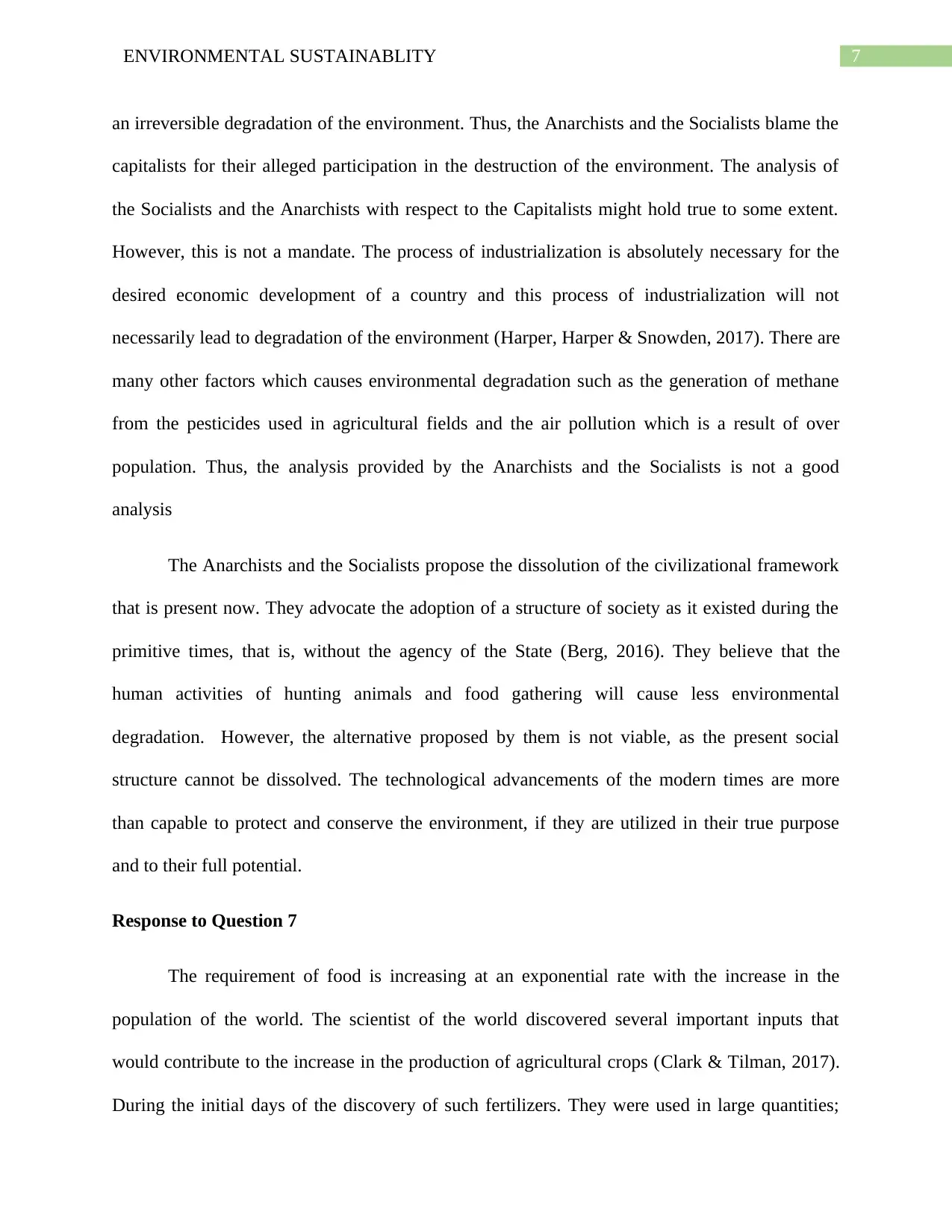
7ENVIRONMENTAL SUSTAINABLITY
an irreversible degradation of the environment. Thus, the Anarchists and the Socialists blame the
capitalists for their alleged participation in the destruction of the environment. The analysis of
the Socialists and the Anarchists with respect to the Capitalists might hold true to some extent.
However, this is not a mandate. The process of industrialization is absolutely necessary for the
desired economic development of a country and this process of industrialization will not
necessarily lead to degradation of the environment (Harper, Harper & Snowden, 2017). There are
many other factors which causes environmental degradation such as the generation of methane
from the pesticides used in agricultural fields and the air pollution which is a result of over
population. Thus, the analysis provided by the Anarchists and the Socialists is not a good
analysis
The Anarchists and the Socialists propose the dissolution of the civilizational framework
that is present now. They advocate the adoption of a structure of society as it existed during the
primitive times, that is, without the agency of the State (Berg, 2016). They believe that the
human activities of hunting animals and food gathering will cause less environmental
degradation. However, the alternative proposed by them is not viable, as the present social
structure cannot be dissolved. The technological advancements of the modern times are more
than capable to protect and conserve the environment, if they are utilized in their true purpose
and to their full potential.
Response to Question 7
The requirement of food is increasing at an exponential rate with the increase in the
population of the world. The scientist of the world discovered several important inputs that
would contribute to the increase in the production of agricultural crops (Clark & Tilman, 2017).
During the initial days of the discovery of such fertilizers. They were used in large quantities;
an irreversible degradation of the environment. Thus, the Anarchists and the Socialists blame the
capitalists for their alleged participation in the destruction of the environment. The analysis of
the Socialists and the Anarchists with respect to the Capitalists might hold true to some extent.
However, this is not a mandate. The process of industrialization is absolutely necessary for the
desired economic development of a country and this process of industrialization will not
necessarily lead to degradation of the environment (Harper, Harper & Snowden, 2017). There are
many other factors which causes environmental degradation such as the generation of methane
from the pesticides used in agricultural fields and the air pollution which is a result of over
population. Thus, the analysis provided by the Anarchists and the Socialists is not a good
analysis
The Anarchists and the Socialists propose the dissolution of the civilizational framework
that is present now. They advocate the adoption of a structure of society as it existed during the
primitive times, that is, without the agency of the State (Berg, 2016). They believe that the
human activities of hunting animals and food gathering will cause less environmental
degradation. However, the alternative proposed by them is not viable, as the present social
structure cannot be dissolved. The technological advancements of the modern times are more
than capable to protect and conserve the environment, if they are utilized in their true purpose
and to their full potential.
Response to Question 7
The requirement of food is increasing at an exponential rate with the increase in the
population of the world. The scientist of the world discovered several important inputs that
would contribute to the increase in the production of agricultural crops (Clark & Tilman, 2017).
During the initial days of the discovery of such fertilizers. They were used in large quantities;
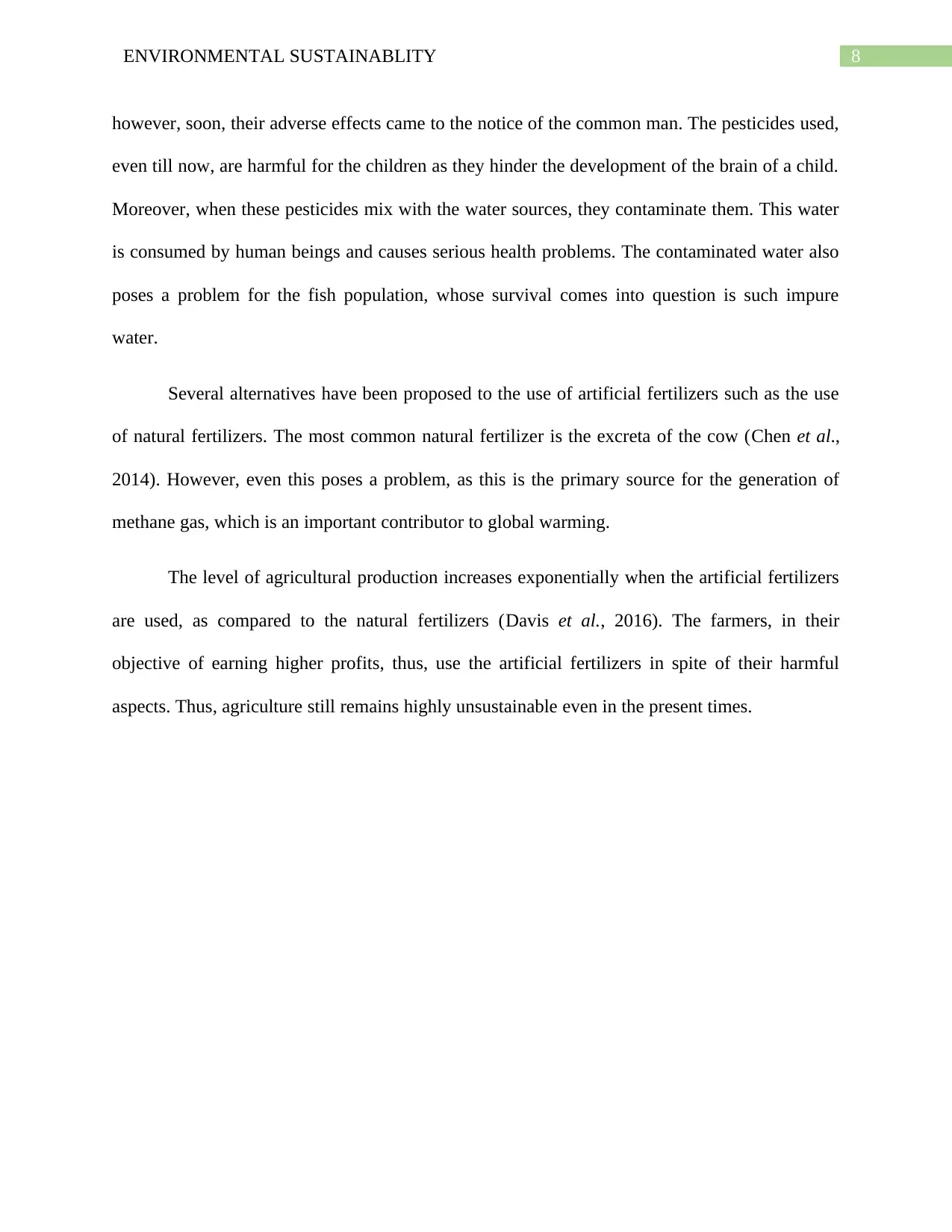
8ENVIRONMENTAL SUSTAINABLITY
however, soon, their adverse effects came to the notice of the common man. The pesticides used,
even till now, are harmful for the children as they hinder the development of the brain of a child.
Moreover, when these pesticides mix with the water sources, they contaminate them. This water
is consumed by human beings and causes serious health problems. The contaminated water also
poses a problem for the fish population, whose survival comes into question is such impure
water.
Several alternatives have been proposed to the use of artificial fertilizers such as the use
of natural fertilizers. The most common natural fertilizer is the excreta of the cow (Chen et al.,
2014). However, even this poses a problem, as this is the primary source for the generation of
methane gas, which is an important contributor to global warming.
The level of agricultural production increases exponentially when the artificial fertilizers
are used, as compared to the natural fertilizers (Davis et al., 2016). The farmers, in their
objective of earning higher profits, thus, use the artificial fertilizers in spite of their harmful
aspects. Thus, agriculture still remains highly unsustainable even in the present times.
however, soon, their adverse effects came to the notice of the common man. The pesticides used,
even till now, are harmful for the children as they hinder the development of the brain of a child.
Moreover, when these pesticides mix with the water sources, they contaminate them. This water
is consumed by human beings and causes serious health problems. The contaminated water also
poses a problem for the fish population, whose survival comes into question is such impure
water.
Several alternatives have been proposed to the use of artificial fertilizers such as the use
of natural fertilizers. The most common natural fertilizer is the excreta of the cow (Chen et al.,
2014). However, even this poses a problem, as this is the primary source for the generation of
methane gas, which is an important contributor to global warming.
The level of agricultural production increases exponentially when the artificial fertilizers
are used, as compared to the natural fertilizers (Davis et al., 2016). The farmers, in their
objective of earning higher profits, thus, use the artificial fertilizers in spite of their harmful
aspects. Thus, agriculture still remains highly unsustainable even in the present times.
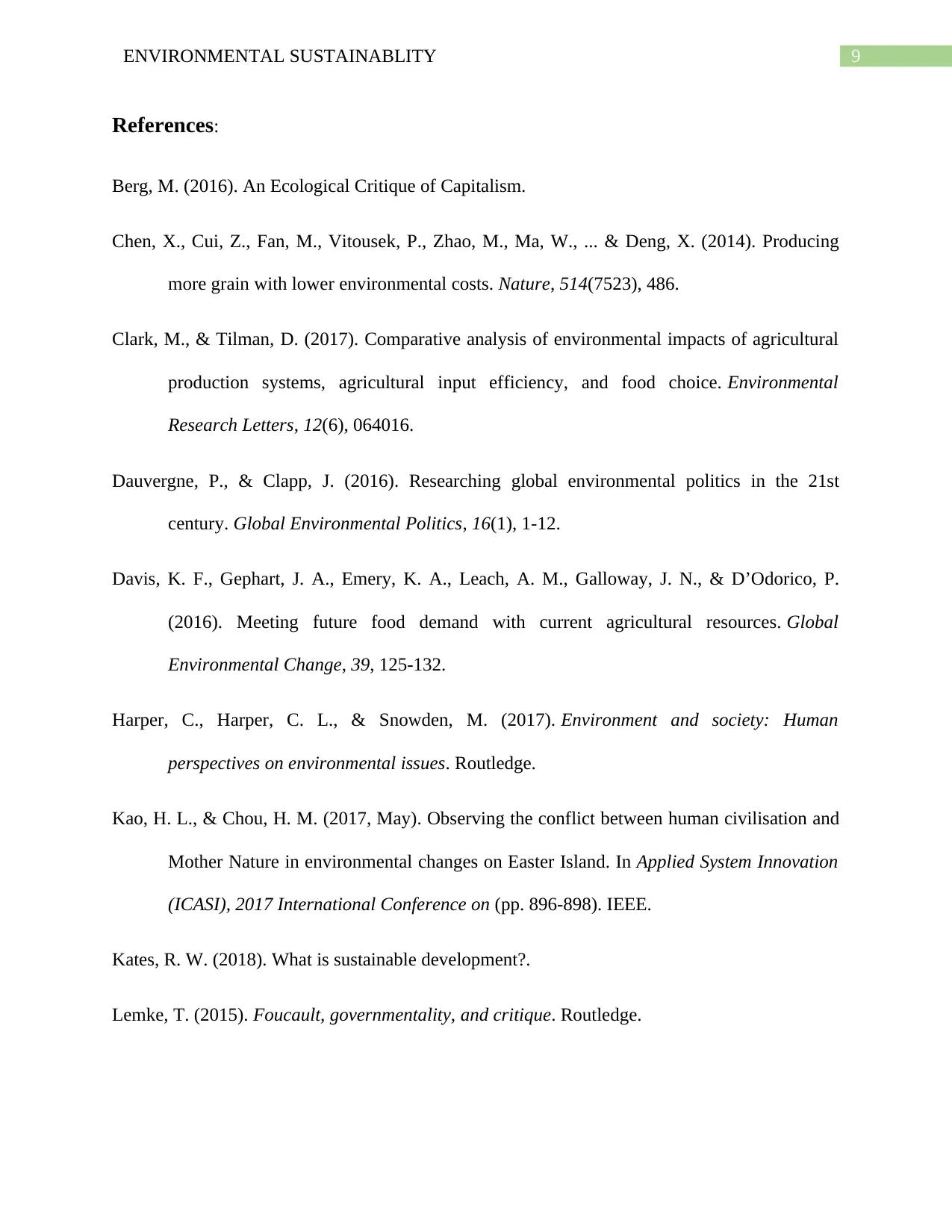
9ENVIRONMENTAL SUSTAINABLITY
References:
Berg, M. (2016). An Ecological Critique of Capitalism.
Chen, X., Cui, Z., Fan, M., Vitousek, P., Zhao, M., Ma, W., ... & Deng, X. (2014). Producing
more grain with lower environmental costs. Nature, 514(7523), 486.
Clark, M., & Tilman, D. (2017). Comparative analysis of environmental impacts of agricultural
production systems, agricultural input efficiency, and food choice. Environmental
Research Letters, 12(6), 064016.
Dauvergne, P., & Clapp, J. (2016). Researching global environmental politics in the 21st
century. Global Environmental Politics, 16(1), 1-12.
Davis, K. F., Gephart, J. A., Emery, K. A., Leach, A. M., Galloway, J. N., & D’Odorico, P.
(2016). Meeting future food demand with current agricultural resources. Global
Environmental Change, 39, 125-132.
Harper, C., Harper, C. L., & Snowden, M. (2017). Environment and society: Human
perspectives on environmental issues. Routledge.
Kao, H. L., & Chou, H. M. (2017, May). Observing the conflict between human civilisation and
Mother Nature in environmental changes on Easter Island. In Applied System Innovation
(ICASI), 2017 International Conference on (pp. 896-898). IEEE.
Kates, R. W. (2018). What is sustainable development?.
Lemke, T. (2015). Foucault, governmentality, and critique. Routledge.
References:
Berg, M. (2016). An Ecological Critique of Capitalism.
Chen, X., Cui, Z., Fan, M., Vitousek, P., Zhao, M., Ma, W., ... & Deng, X. (2014). Producing
more grain with lower environmental costs. Nature, 514(7523), 486.
Clark, M., & Tilman, D. (2017). Comparative analysis of environmental impacts of agricultural
production systems, agricultural input efficiency, and food choice. Environmental
Research Letters, 12(6), 064016.
Dauvergne, P., & Clapp, J. (2016). Researching global environmental politics in the 21st
century. Global Environmental Politics, 16(1), 1-12.
Davis, K. F., Gephart, J. A., Emery, K. A., Leach, A. M., Galloway, J. N., & D’Odorico, P.
(2016). Meeting future food demand with current agricultural resources. Global
Environmental Change, 39, 125-132.
Harper, C., Harper, C. L., & Snowden, M. (2017). Environment and society: Human
perspectives on environmental issues. Routledge.
Kao, H. L., & Chou, H. M. (2017, May). Observing the conflict between human civilisation and
Mother Nature in environmental changes on Easter Island. In Applied System Innovation
(ICASI), 2017 International Conference on (pp. 896-898). IEEE.
Kates, R. W. (2018). What is sustainable development?.
Lemke, T. (2015). Foucault, governmentality, and critique. Routledge.
Secure Best Marks with AI Grader
Need help grading? Try our AI Grader for instant feedback on your assignments.
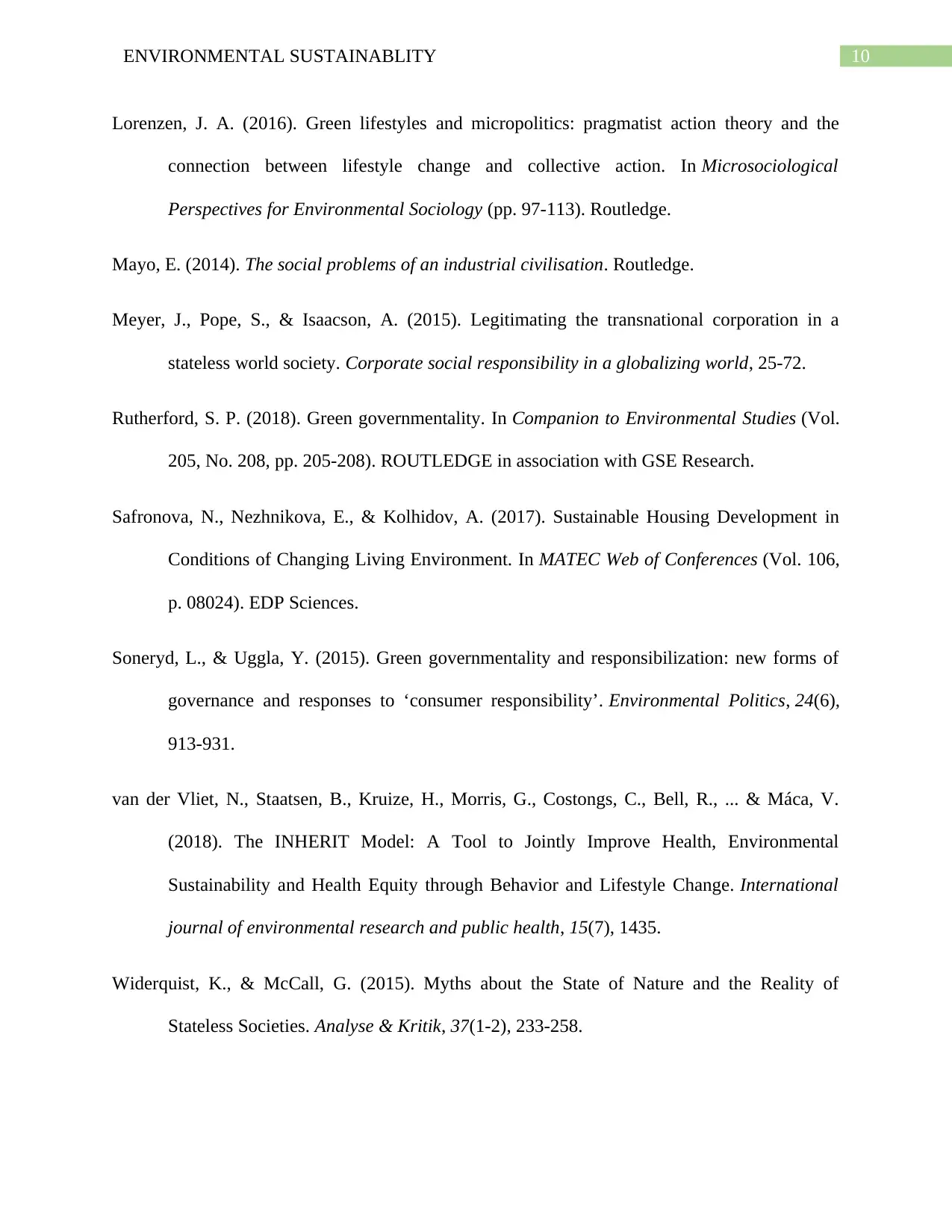
10ENVIRONMENTAL SUSTAINABLITY
Lorenzen, J. A. (2016). Green lifestyles and micropolitics: pragmatist action theory and the
connection between lifestyle change and collective action. In Microsociological
Perspectives for Environmental Sociology (pp. 97-113). Routledge.
Mayo, E. (2014). The social problems of an industrial civilisation. Routledge.
Meyer, J., Pope, S., & Isaacson, A. (2015). Legitimating the transnational corporation in a
stateless world society. Corporate social responsibility in a globalizing world, 25-72.
Rutherford, S. P. (2018). Green governmentality. In Companion to Environmental Studies (Vol.
205, No. 208, pp. 205-208). ROUTLEDGE in association with GSE Research.
Safronova, N., Nezhnikova, E., & Kolhidov, A. (2017). Sustainable Housing Development in
Conditions of Changing Living Environment. In MATEC Web of Conferences (Vol. 106,
p. 08024). EDP Sciences.
Soneryd, L., & Uggla, Y. (2015). Green governmentality and responsibilization: new forms of
governance and responses to ‘consumer responsibility’. Environmental Politics, 24(6),
913-931.
van der Vliet, N., Staatsen, B., Kruize, H., Morris, G., Costongs, C., Bell, R., ... & Máca, V.
(2018). The INHERIT Model: A Tool to Jointly Improve Health, Environmental
Sustainability and Health Equity through Behavior and Lifestyle Change. International
journal of environmental research and public health, 15(7), 1435.
Widerquist, K., & McCall, G. (2015). Myths about the State of Nature and the Reality of
Stateless Societies. Analyse & Kritik, 37(1-2), 233-258.
Lorenzen, J. A. (2016). Green lifestyles and micropolitics: pragmatist action theory and the
connection between lifestyle change and collective action. In Microsociological
Perspectives for Environmental Sociology (pp. 97-113). Routledge.
Mayo, E. (2014). The social problems of an industrial civilisation. Routledge.
Meyer, J., Pope, S., & Isaacson, A. (2015). Legitimating the transnational corporation in a
stateless world society. Corporate social responsibility in a globalizing world, 25-72.
Rutherford, S. P. (2018). Green governmentality. In Companion to Environmental Studies (Vol.
205, No. 208, pp. 205-208). ROUTLEDGE in association with GSE Research.
Safronova, N., Nezhnikova, E., & Kolhidov, A. (2017). Sustainable Housing Development in
Conditions of Changing Living Environment. In MATEC Web of Conferences (Vol. 106,
p. 08024). EDP Sciences.
Soneryd, L., & Uggla, Y. (2015). Green governmentality and responsibilization: new forms of
governance and responses to ‘consumer responsibility’. Environmental Politics, 24(6),
913-931.
van der Vliet, N., Staatsen, B., Kruize, H., Morris, G., Costongs, C., Bell, R., ... & Máca, V.
(2018). The INHERIT Model: A Tool to Jointly Improve Health, Environmental
Sustainability and Health Equity through Behavior and Lifestyle Change. International
journal of environmental research and public health, 15(7), 1435.
Widerquist, K., & McCall, G. (2015). Myths about the State of Nature and the Reality of
Stateless Societies. Analyse & Kritik, 37(1-2), 233-258.
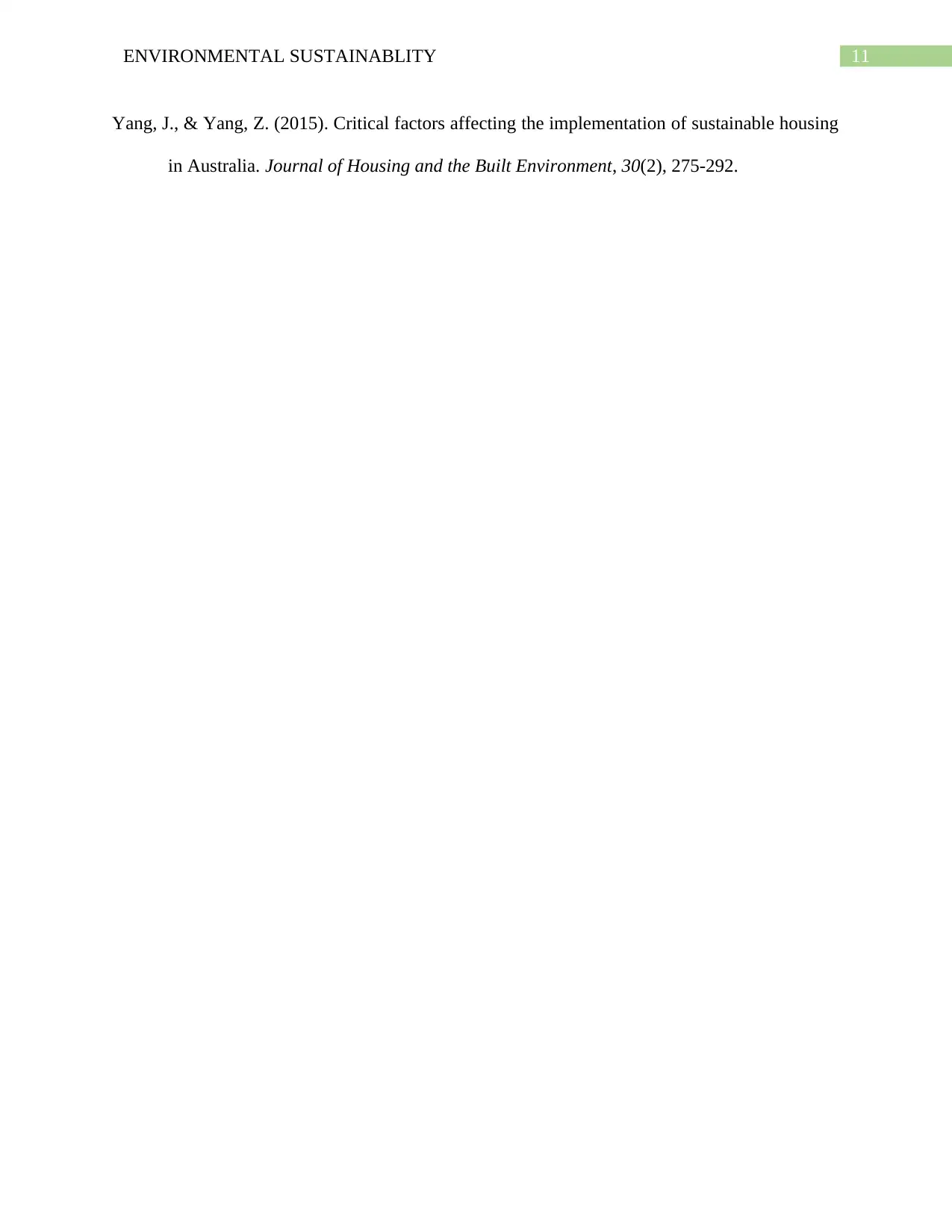
11ENVIRONMENTAL SUSTAINABLITY
Yang, J., & Yang, Z. (2015). Critical factors affecting the implementation of sustainable housing
in Australia. Journal of Housing and the Built Environment, 30(2), 275-292.
Yang, J., & Yang, Z. (2015). Critical factors affecting the implementation of sustainable housing
in Australia. Journal of Housing and the Built Environment, 30(2), 275-292.
1 out of 12
Related Documents
Your All-in-One AI-Powered Toolkit for Academic Success.
+13062052269
info@desklib.com
Available 24*7 on WhatsApp / Email
![[object Object]](/_next/static/media/star-bottom.7253800d.svg)
Unlock your academic potential
© 2024 | Zucol Services PVT LTD | All rights reserved.





